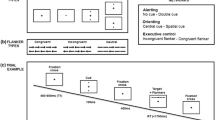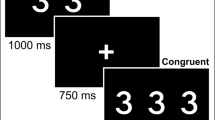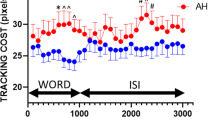Abstract
Objective
This study evaluated whether alcohol attentional bias is an artifact of excessive drinkers’ impaired cognitive functioning, which adversely affects their performance on the classic Stroop test (a measure of inhibitory control) and the Shipley Institute of Living Scale (SILS; a measure of verbal and abstraction ability). Both tests measure aspects of executive cognitive functioning (ECF).
Methods
Social drinkers (N=87) and alcohol-dependent drinkers (N=47) completed a measure of alcohol consumption, classic and alcohol-related Stroop tests, and the SILS.
Results
A multivariate analysis of variance (MANOVA) showed that the dependent drinkers were poorer on the cognitive measures (SILS scores and classic Stroop interference) and had greater alcohol attentional bias than the social drinkers. An analysis of covariance (ANCOVA) in which the cognitive measures were controlled showed that the dependent drinkers’ greater alcohol attentional bias was not an artifact of their poorer cognitive performance.
Conclusion
The results are discussed in terms of cognitive–motivational models, which suggest that excessive drinking sensitizes alcohol abusers’ attentional responsiveness to alcohol-related stimuli to a degree that exceeds the adverse effects of alcohol on their general cognitive functioning.
Similar content being viewed by others
Notes
The stimuli in the four blocks were as follows. Block 1: beer, whisky, scotch, liquor, tequila, bar, rum; gate, shed cupboard, tap, fence, toilet, ceiling. Block 2: shot, shorts, vodka, pint, liqueur, alcohol, bourbon; garden, shelf, alcove, carpet, chimney, radiator, stove. Block 3: wine, bitter, stout, pub, brandy, champagne, mead; hall, tail, patio, drainpipe, socket, doorknob, roof. Block 4: drink, sherry, cider, booze, spirit, gin, cocktail; bath, stairs, balcony, porch, lamp, fireplace, sink.
An alcopop is an alcoholic beverage that came on the market in the United Kingdom in 1995. It is a sweet, effervescent fruit drink, usually with about 5% of alcohol by volume.
In Cohen (1992), an f represents the effect size for an ANOVA model; values of 0.10, 0.25, and 0.40 are defined as small, medium, and large, respectively.
References
Adleman NE, Menon V, Blasey CM, White CD, Warsofsky IS, Glover GH, Reiss AL (2002) A developmental fMRI study of the Stroop color–word task. Neuroimage 16(1):61–75
Algom D, Chajut E, Lev S (2004) A rational look at the emotional Stroop phenomenon: a generic slowdown, not a Stroop effect. J Exp Psychol Gen 133(3):323–338
Allman JM, Hakeem A, Erwin JM, Nimchinsky E, Hof P (2001) The anterior cingulate cortex. The evolution of an interface between emotion and cognition. Ann N Y Acad Sci 935:107–117
Ardouin C, Pillon B, Peiffer E, Bejjani P, Limousin P, Damier P, Arnulf I, Benabid AL, Agid Y, Pollak P (1999) Bilateral subthalamic or pallidal stimulation for Parkinson’s disease affects neither memory nor executive functions: a consecutive series of 62 patients. Ann Neurol 46(2):217–223
Baayen HR, Piepenbrock R, van Rijn H (1993) The CELEX lexical database (CD-ROM). Linguistic Data Consortium, University of Pennsylvania, Philadelphia, PA
Bantick SJ, Wise RG, Ploghaus A, Clare S, Smith SM, Tracey I (2002) Imaging how attention modulates pain in humans using functional MRI. Brain 125(Pt 2):310–319
Bauer D, Cox WM (1998) Alcohol related words are distracting to both alcohol abusers and non-abusers in the Stroop colour-naming task. Addiction 93(10):1539–1542
Blume AW, Marlatt GA, Schmaling KB (2000) Executive cognitive function and heavy drinking behavior among college students. Psychol Addict Behav 14(3):299–302
Brown M, Besner D (2001) On a variant of Stroop’s paradigm: which cognitions press your buttons? Mem Cognit 29(6):903–904
Brown SA, Tapert SF, Granholm E, Delis DC (2000) Neurocognitive functioning of adolescents: effects of protracted alcohol use. Alcohol Clin Exp Res 24:164–171
Bunge SA, Klingberg T, Jacobsen RB, Gabrieli JD (2000) A resource model of the neural basis of executive working memory. Proc Natl Acad Sci U S A 97(7):3573–3578
Bush G, Frazier JA, Rauch SL, Seidman LJ, Whalen PJ, Jenike MA, Rosen BR, Biederman J (1999) Anterior cingulate cortex dysfunction in attention-deficit/hyperactivity disorder revealed by fMRI and the Counting Stroop. Biol Psychiatry 45(12):1542–1552
Bush G, Luu P, Posner MI (2000) Cognitive and emotional influences in anterior cingulate cortex. Trends Cogn Sci 4(6):215–222
Cabeza R, Nyberg L (2000) Imaging cognition II: an empirical review of 275 PET and fMRI studies. J Cogn Neurosci 12(1):1–47
Carter CS, Macdonald AM, Botvinick M, Ross LL, Stenger A, Noll D, Cohen JD (2000) Parsing executive processes: strategic vs. evaluative functions of the anterior cingulate cortex. Proc Natl Acad Sci U S A 97(4):1944–1948
Cedrus Corporation (1999) SuperLab Pro SKD (version 2.1) [software]. Cedrus Corporation, San Pedro, CA, USA
Childress AR, Mozley PD, McElgin W, Fitzgerald J, Reivich M, O’Brien CP (1999) Limbic activation during cue-induced cocaine craving. Am J Psychiatry 156(1):11–18
Ciesielski KT, Waldorf AV, Jung RE (1995) Anterior brain deficits in chronic alcoholism—cause or effect? J Nerv Ment Dis 183(12):756–761
Cohen J (1992) A power primer. Psychol Bull 112(1):155–159
Connor PD, Sampson PD, Bookstein FL, Barr HM, Streissguth AP (2000) Direct and indirect effects of prenatal alcohol damage on executive function. Dev Neuropsychol 18(3):331–354
Cox WM (2000) Alcohol Use Questionnaire. Unpublished questionnaire. University of Wales, Bangor
Cox WM, Klinger E (1988) A motivational model of alcohol use. J Abnorm Psychol 97:168–180
Cox WM, Klinger E (1990) Incentive motivation, affective change, and alcohol use: a model. In: Cox WM (ed) Why people drink: parameters of alcohol as a reinforcer. Gardner, New York, pp 291–314
Cox WM, Klinger E (2004) A motivational model of alcohol use: Determinants of use and change. In: Cox WM, Klinger E (eds) Handbook of motivational counseling: concepts, approaches, and assessment. Wiley, Chichester, UK, pp 121–138
Cox WM, Fadardi JS, Pothos EM (2005) The alcohol-Stroop test: theoretical considerations and procedural recommendations. Psychol Bull (in press)
Crombez G, Hermans D, Adriaensen H (2000) The emotional Stroop task and chronic pain: what is threatening for chronic pain sufferers? Eur J Pain 4(1):37–44
Dao-Castellana MH, Samson Y, Legault F, Martinot JL, Aubin HJ, Crouzel C, Feldman L, Barrucand D, Rancurel G, Feline A, Syrota A (1998) Frontal dysfunction in neurologically normal chronic alcoholic subjects: metabolic and neuropsychological findings. Psychol Med 28(5):1039–1048
Davidson RJ (1998) Affective style and affective disorders: perspectives from affective neuroscience. Cogn Emot 12(3):307–330
Davidson RJ, Irwin W (1999) The functional neuroanatomy of emotion and affective style. Trends Cogn Sci 3(1):11–21
Deckel AW, Bauer L, Hesselbrock V (1995) Anterior brain dysfunctioning as a risk factor in alcoholic behaviors. Addiction 90(10):1323–1334
Derbyshire SW, Vogt BA, Jones AK (1998) Pain and Stroop interference tasks activate separate processing modules in anterior cingulate cortex. Exp Brain Res 118(1):52–60
de Ruiter C, Brosschot JF (1994) The emotional Stroop interference effect in anxiety: attentional bias or cognitive avoidance? Behav Res Ther 32(3):315–319
Duka T, Townshend JM (2004) The priming effect of alcohol pre-load on attentional bias to alcohol-related stimuli. Psychopharmacology (Berl) 176(3–4):353–361
Fadda F, Rossetti Z (1998) Chronic ethanol consumption: from neuroadaptation to neurodegeneration. Prog Neurobiol 56:385–431
Fuentes LJ (2001) Selective attention deficit in schizophrenia. Rev Neurol 32(4):387–391
George MS, Ketter TA, Parekh PI, Rosinsky N, Ring HA, Pazzaglia PJ, Marangell LB, Callahan AM, Post RM (1997) Blunted left cingulate activation in mood disorder subjects during a response interference task (the Stroop). J Neuropsychiatry Clin Neurosci 9(1):55–63
George MS, Anton RF, Bloomer C, Teneback C, Drobes DJ, Lorberbaum JP, Nahas Z, Vincent DJ (2001) Activation of prefrontal cortex and anterior thalamus in alcoholic subjects on exposure to alcohol-specific cues. Arch Gen Psychiatry 58(4):345–352
Grant I, Mohns L (1975) Chronic cerebral effects of alcohol and drug abuse. Int J Addict 10(5):883–920
Grant S, London ED, Newlin DB, Villemagne VL, Liu X, Contoreggi C, Phillips RL, Kimes AS, Margolin A (1996) Activation of memory circuits during cue-elicited cocaine craving. Proc Natl Acad Sci U S A 93(21):12040–12045
Green MW, Rogers PJ (1993) Selective attention to food and body shape words in dieters and restrained nondieters. Int J Eat Disord 14(4):515–517
Heather N, Peters Timothy J, Stockwell T (2001) International handbook of alcohol dependence and problems. Wiley, Chichester
Hoaken PN, Giancola PR, Pihl RO (1998) Executive cognitive functions as mediators of alcohol-related aggression. Alcohol Alcohol 33(1):47–54
Jones BT, Jones BC, Smith H, Copely N (2003) A flicker paradigm for inducing change blindness reveals alcohol and cannabis information processing biases in social users. Addiction 98:235–244
Kilts CD, Schweitzer JB, Quinn CK, Gross RE, Faber TL, Muhammad F, Ely TD, Hoffman JM, Drexler KP (2001) Neural activity related to drug craving in cocaine addiction. Arch Gen Psychiatry 58(4):334–341
Kinderman P (1994) Attentional bias, persecutory delusions and the self-concept. Br J Med Psychol 67(Pt 1):53–66
Kindt M, Bierman D, Brosschot JF (1997) Cognitive bias in spider fear and control children: assessment of emotional interference by a card format and a single-trial format of the Stroop task. J Exp Child Psychol 66(2):163–179
King AC, Bernardy NC, Hauner K (2003) Stressful events, personality, and mood disturbance: Gender differences in alcoholics and problem drinkers. Addict Behav 28(1):171–187
Klinger E (1975) Consequences of commitment to and disengagement from incentives. Psychol Rev 82(1):1–25
Klinger E (1977). Meaning and void: inner experience and the incentives in people’s lives. University of Minnesota Press, Minneapolis
Klinger E (1987). Current concerns and disengagement from incentives. In: Halisch F, Kuhl J (eds) Motivation, attention, and volition. Springer, Berlin, Heidelberg, New York, pp 337–347
Klinger E (1996) The contents of thoughts: interference as the downside of adaptive normal mechanisms in thought flow. In: Sarason IG, Sarason BR, Pierce GR (eds) Cognitive interference: theories, methods, and findings. Lawrence Erlbaum, Hillsdale, NJ, pp 3–23
Klinger E, Cox WM (2004) Motivation and the theory of current concerns. In: Cox WM, Klinger E (eds) Handbook of motivational counseling: concepts, approaches, and assessment. Wiley, Chichester, UK, pp 3–27
Koob GF (2003) Alcoholism: allostasis and beyond. Alcohol Clin Exp Res 27(2):232–243
Kucera H, Francis WN (1967) Computational analysis of present-day American English. Brown University Press, Providence, RI
Lawton-Craddock A, Nixon SJ, Tivis R (2003) Cognitive efficiency in stimulant abusers with and without alcohol dependence. Alcohol Clin Exp Res 27(3):457–464
Lyvers M (2000) “Loss of control” in alcoholism and drug addiction: a neuroscientific interpretation. Exp Clin Psychopharmacol 8(2):225–249
MacLeod CM (1991) Half a century of research on the Stroop effect: an integrative review. Psychol Bull 109(2):163–203
MacLeod CM, MacDonald PA (2000) Interdimensional interference in the Stroop effect: uncovering the cognitive and neural anatomy of attention. Trends Cogn Sci 4(10):383–391
Mantere T, Tupala E, Hall H, Sarkioja T, Rasanen P, Bergstrom K, Callaway J, Tiihonen J (2002) Serotonin transporter distribution and density in the cerebral cortex of alcoholic and nonalcoholic comparison subjects: a whole-hemisphere autoradiography study. Am J Psychiatry 159(4):599–606
Marksteiner J, Bodner T, Gurka P (2002) Alcohol-induced cognitive disorder: alcohol dementia. Wien Med Wochenschr 152(3–4):98–101
Maylor EA, Rabbitt PM (1993) Alcohol, reaction time and memory: a meta-analysis. Br J Psychol 84(Pt 3):301–317
McCusker CG (2001) Cognitive biases and addiction: an evolution in theory and method. Addiction 96(1):47–56
Mega MS, Cummings JL (1994) Frontal–subcortical circuits and neuropsychiatric disorders. J Neuropsychiatry Clin Neurosci 6(4):358–370
Mogg K, Bradley BP, Millar N, White J (1995) A follow-up study of cognitive bias in generalized anxiety disorder. Behav Res Ther 33:927–935
Monahan JS (2001) Coloring single Stroop elements: reducing automaticity or slowing color processing? J Gen Psychol 128(1):98–112
Moselhy HF, Georgiou G, Kahn A (2001) Frontal lobe changes in alcoholism: a review of the literature. Alcohol Alcohol 36(5):357–368
Nassauer KW, Halperin JM (2003) Dissociation of perceptual and motor inhibition processes through the use of novel computerized conflict tasks. J Int Neuropsychol Soc 9(1):25–30
Nixon SJ, Parsons OA, Schaeffer KW, Hale RL (1995) A methodological study of the Shipley Institute of Living Scale in alcoholics and non-alcoholics: reliability, discriminating items and alternate forms. Appl Neuropsychol 2(3/4):155–160
Noel X, Van der Linden M, Schmidt N, Sferrazza R, Hanak C, Le Bon O, De Mol J, Kornreich C, Pelc I, Verbanck P (2001) Supervisory attentional system in nonamnesic alcoholic men. Arch Gen Psychiatry 58(12):1152–1158
Noel X, Sferrazza R, Van Der Linden M, Paternot J, Verhas M, Hanak C, Pelc I, Verbanck P (2002) Contribution of frontal cerebral blood flow measured by 99 mTc-bicisate SPECT and executive function deficits to predicting treatment outcome in alcohol-dependent patients. Alcohol Alcohol 37(4):347–354
Pardo JV, Pardo PJ, Janer KW, Raichle ME (1990) The anterior cingulate cortex mediates processing selection in the Stroop attentional conflict paradigm. Proc Natl Acad Sci U S A 87(1):256–259
Parker ES, Birnbaum IM, Boyd RA, Noble EP (1980) Neuropsychologic decrements as a function of alcohol intake in male students. Alcohol Clin Exp Res 4(3):330–334
Paulus MP, Hozack N, Frank L, Brown GG (2002) Error rate and outcome predictability affect neural activation in prefrontal cortex and anterior cingulate during decision-making. Neuroimage 15(4):836–846
Pothos EM, Cox WM (2002) Cognitive bias for alcohol-related information in inferential processes. Drug Alcohol Depend 66(3):235–241
Ravnkilde B, Videbech P, Rosenberg R, Gjedde A, Gade A (2002) Putative tests of frontal lobe function: a PET-study of brain activation during Stroop’s Test and verbal fluency. J Clin Exp Neuropsychol 24(4):534–547
Riemann BC, McNally RJ (1995) Cognitive processing of personally relevant information. Cogn Emot 9(4):325–340
Roberts AJ, Koob GF (1997) The neurobiology of addiction: an overview. Alcohol Health Res World 21(2):101–106
Robinson TE, Berridge KC (1993) The neural basis of drug craving: an incentive-sensitization theory of addiction. Brain Res Rev 18(3):247–291
Robinson TE, Berridge KC (2003) Addiction. Annu Rev Psychol 54(1):25–53
Salgado-Pineda P, Vendrell P, Bargallo N, Falcon C, Junque C (2002) Functional magnetic resonance in the evaluation of the activity of the anterior cingulate cortex using Stroop’s paradigm. Rev Neurol 34(7):607–611
Selzer ML (1971) The Michigan Alcoholism Screening Test: the quest for a new diagnostic instrument. Am J Psychiatry 127(12):89–94
Serra-Mestres J, Ring HA (2002) Evidence supporting a cognitive model of depression in Parkinson’s disease. J Nerv Ment Dis 190(6):407–410
Sharma D, McKenna FP (2001) The role of time pressure on the emotional Stroop task. Br J Psychol 92(Pt 3):471–481
Skutle A, Berg G (1987) Training in controlled drinking for early-stage problem drinkers. Br J Addict 82(5):493–501
Smith EE, Jonides J (1999) Storage and executive processes in the frontal lobes. Science 283(5408):1657–1661
Spinks H, Dalgleish T (2001) Attentional processing and levels of symptomatology in Seasonal Affective Disorder (SAD): a preliminary longitudinal study. J Affect Disord 62(3):229–232
Stacy AW (1997) Memory activation and expectancy as prospective predictors of alcohol and marijuana use. J Abnorm Psychol 106:61–73
Steel C, Haworth EJ, Peters E, Hemsley DR, Sharma T, Gray JA, Pickering A, Gregory L, Simmons A, Bullmore ET, Williams SC (2001) Neuroimaging correlates of negative priming. Neuroreport 12(16):3619–3624
Stetter F, Ackermann K, Bizer A, Straube ER, Mann K (1995) Effects of disease-related cues in alcoholic inpatients: results of a controlled “Alcohol Stroop” study. Alcohol Clin Exp Res 19(3):593–599
Stormark KM, Laberg JC, Nordby H, Hugdahl K (2000) Alcoholics’ selective attention to alcohol stimuli: automated processing? J Stud Alcohol 61(1):18–23
Stroop JR (1935) Studies of interference in serial verbal reaction. J Exp Psychol 18:643–662
Swick D, Jovanovic J (2002) Anterior cingulate cortex and the Stroop task: neuropsychological evidence for topographic specificity. Neuropsychologia 40(8):1240–1253
Tiffany ST (1990) A cognitive model of drug urges and drug-use behavior: role of automatic and nonautomatic processes. Psychol Rev 97(2):147–168
van Veen V, Cohen JD, Botvinick MM, Stenger VA, Carter CS (2001) Anterior cingulate cortex, conflict monitoring, and levels of processing. Neuroimage 14(6):1302–1308
Vogel-Sprott M, Easdon C, Fillmore M, Finn P, Justus A (2001) Alcohol and behavioral control: cognitive and neural mechanisms. Alcohol Clin Exp Res 25(1):117–121
Vogt BA, Finch DM, Olson CR (1992) Functional heterogeneity in cingulate cortex: the anterior executive and posterior evaluative regions. Cereb Cortex 2(6):435–443
Waters H, Green MW (2003) A demonstration of attentional bias, using a novel dual task paradigm, towards clinically salient material in recovering alcohol abuse patients? Psychol Med 33(3):491–498
Watts FN, McKenna FP, Sharrock R, Trezise L (1986) Colour naming of phobia-related words. Br J Psychol 77(Pt 1):97–108
Wehr A, Bauer LO (1999) Verbal ability predicts abstinence from drugs and alcohol in a residential treatment population. Psychol Rep 84(3 Pt 2):1354–1360
Wells A, Matthews G (1999) The cognitive science of attention and emotion. In: Dalgleish T, Power MJ (eds) Handbook of cognition and emotion. Wiley, Chichester, UK
Whalen PJ, Bush G, McNally RJ, Wilhelm S, McInerney SC, Jenike MA, Rauch SL (1998) The emotional counting Stroop paradigm: a functional magnetic resonance imaging probe of the anterior cingulate affective division. Biol Psychiatry 44(12):1219–1228
Wiers RW, van Woerden N, Smulders FT, de Jong PJ (2002) Implicit and explicit alcohol-related cognitions in heavy and light drinkers. J Abnorm Psychol 111(4):648–658
Wiers RW, Cox WM, Field M, Fadardi JW, Palfai T, Schoenmakers T et al (2005) The search for new ways to change implicit alcohol-related cognitions in heavy drinkers. Alcohol Clin Exp Res (in press)
Williams JM, Mathews A, MacLeod C (1996) The emotional Stroop task and psychopathology. Psychol Bull 120(1):3–24
Wright I, Waterman M, Prescott H, Murdoch-Eaton D (2003) A new Stroop-like measure of inhibitory function development: typical developmental trends. J Child Psychol Psychiatry Allied Discipl 44(4):561–575
Zachary RA (2000) Shipley Institute of Living Scale: revised manual. Western Psychological Services, Los Angeles
Zack M, Belsito L, Scher R, Eissenberg T, Corrigall WA (2001) Effects of abstinence and smoking on information processing in adolescent smokers. Psychopharmacology (Berl) 153(2):249–257
Zeigler DW, Wang CC, Yoast RA, Dickinson BD, McCaffree MA, Robinowitz CB, Sterling ML (2005) The neurocognitive effects of alcohol on adolescents and college students. Prev Med 40(1):23–32
Author information
Authors and Affiliations
Corresponding author
Rights and permissions
About this article
Cite this article
Fadardi, J.S., Cox, W.M. Alcohol attentional bias: drinking salience or cognitive impairment?. Psychopharmacology 185, 169–178 (2006). https://doi.org/10.1007/s00213-005-0268-0
Received:
Accepted:
Published:
Issue Date:
DOI: https://doi.org/10.1007/s00213-005-0268-0




